|
Skip to content Social Security Online |
Actuarial Publications | |
|
|
Home FAQs Contact Us Search |
| Office of the Chief Actuary |
The 1997 OASDI Trustees ReportUpdated September 9, 1997 Historical document |
|
The Board of Trustees is established under the Social Security Act to oversee the financial operations of the Federal Old-Age and Survivors Insurance Trust Fund and the Federal Disability Insurance Trust Fund. The Board is composed of six members, four of whom serve automatically by virtue of their positions in the Federal Government: the Secretary of the Treasury, who is the Managing Trustee, the Secretary of Labor, the Secretary of Health and Human Services, and the Commissioner of Social Security. The other two members are appointed by the President and confirmed by the Senate to serve as public representatives: Stephen G. Kellison and Marilyn Moon are currently serving 4-year terms that began on July 20, 1995.
The Social Security Act requires that the Board, among other duties, report annually to the Congress on the financial and actuarial status of the OASI and DI Trust Funds. This annual report, for 1997, is the 57th such report.
The Council was composed of a Chair and 12 members representing employers and employees, self-employed persons, and the public. The Council's charge was focused on the OASDI program. Among the areas the Secretary specifically asked the Council to examine was Social Security financing. The Advisory Council submitted its report to the Secretary of Health and Human Services and the Commissioner of Social Security on January 6, 1997.
The Council's report presents three alternative sets of recommendations for restoring the long-range actuarial balance of the OASDI program. The first approach would maintain the Social Security benefit
and tax structure essentially as it is in the current program, with the
possibility that a portion of trust-fund assets be invested in private
equities and managed by the Federal Government. Another approach
would privatize a significant portion of the current program by directing 5 percentage points of each worker's contributions (from the current 12.4-percent contribution rate for employees and employers,
combined) to a "Personal Security Account". Transition costs under
this plan would require additional financing equivalent to 1.52 percent of taxable earnings over the first 72 years. A third approach
would scale back benefits to levels that could be financed by the current 12.4-percent contribution rate and establish a defined contribution benefit plan, an Individual Account for each worker, through an
additional 1.6-percent mandatory contribution payable by the worker
to an investment account managed by the Federal Government.
C. HIGHLIGHTS
Short-Range Results
Long-Range Results
Estimated Operations of the Trust Funds
D. TRUST FUND FINANCIAL OPERATIONS
|
| |||||||
|
|
OASI | DI | OASDI | ||||
| Total income | $363.7 |
$60.7 |
$424.5 | ||||
| Payroll taxes | 321.6 | 57.3 | 378.9 | ||||
| Taxation of benefits | 6.5 | .4 | 6.8 | ||||
| Interest | 35.7 | 3.0 | 38.7 | ||||
| Total expenditures | 308.2 |
45.4 |
353.6 | ||||
| Benefit payments | 302.9 | 44.2 | 347.0 | ||||
| Railroad Retirement financial interchange | 3.6 | (1/) | 3.6 | ||||
| Administrative expenses | 1.8 | 1.2 | 3.0 | ||||
| 1
Less than $50 million.
Note: Totals do not necessarily equal the sums of rounded components. | |||||||
| OASI | DI | OASDI | HI | Total for OASDI and HI | |
| Tax rate for employees and employers, each (in percent) | 5.35 | 0.85 | 6.20 | 1.45 | 7.65 |
| Tax rate for self-employed persons (in percent) | 10.70 | 1.70 | 12.40 | 2.90 | 15.30 |
The tax rates for OASDI and for HI are not scheduled to change from
their current values under present law. The maximum amount of
earnings subject to OASDI taxes increases automatically each year,
based on the increase in the average wage for all workers. In calendar
year 1996, OASDI payroll tax income amounted to $378.9 billion, representing 89 percent of the total income received under the OASDI
program during the year.
Beneficiaries whose "adjusted gross income" exceeds certain threshold amounts must pay income taxes on up to 85 percent of their annual OASDI benefits. The income tax revenue that results from taxing up to 50 percent of those benefits, together with taxes withheld from the benefits paid to nonresident aliens, is credited to the OASI and DI Trust Funds and totaled $6.8 billion in 1996. (The additional tax revenue that results from taxing up to 85 percent of benefits is credited to the HI Trust Fund.)
The final source of income to the trust funds is from interest on the invested assets of the funds. By law, these investments must be in interest-bearing securities of the U.S. Government or in securities guaranteed by the United States. Interest from investments in 1996 amounted to $38.7 billion. This represented an effective annual interest rate of 7.6 percent, earned by the assets of the trust funds during calendar year 1996. During the same period, the average interest rate on new securities purchased by the trust funds was 6.6 percent.
2. Expenditures
In 1996, benefit payments totaling $347.0 billion were made to retired
and disabled workers and their families, and to survivors of deceased
workers. Such payments represent 98 percent of all expenditures by
the OASDI program. An additional $3.6 billion was transferred from
the OASI and DI Trust Funds to the Railroad Retirement program in
1996, under provisions of the law requiring a financial interchange
between the two programs. The cost of administering the OASDI program in 1996 was $3.0 billion, or about 0.9 percent of total benefits
paid during the year.
3. Trust Fund Assets
In 1996, total income was $424.5 billion and total expenditures were
$353.6 billion. The assets of the OASI and DI Trust Funds therefore
increased by a net total of $70.9 billion during the year, from $496.1
billion to $567.0 billion. The invested assets of the trust funds are
backed by the full faith and credit of the U.S. Government, in the
same way as other public-debt obligations of the United States.
When program income exceeds expenditures, the trust fund serves as a vehicle to help fund a portion of the program's accruing financial obligations in advance. In particular, as invested assets continue to increase over the next 20 to 30 years, interest earnings will become a larger share of total trust fund income. In 1996, interest income to the combined OASI and DI Trust Funds represented 9.1 percent of total OASDI income. On a combined basis, interest income in 2006 would represent an estimated 13.6 percent of total income.
Conversely, if income to a trust fund is inadequate to defray expenditures, the fund's assets serve as a contingency reserve to cover the shortfall temporarily. For example, the expenditures of the DI Trust Fund exceeded income to the fund for most of 1994 (prior to enactment of the OASDI tax rate reallocation), necessitating a redemption of assets to cover the difference. In the event of recurring shortfalls, the availability of trust fund assets allows time for the enactment and implementation of legislation to restore financial stability to the program.
A period of 75 years is used to evaluate the long-range actuarial status of the
program in order to obtain the full range of financial commitments that will be
incurred on behalf of all current program
participants. For example, a group of workers now entering the labor
force at age 22 will work and pay OASDI taxes for the next 45 years
before reaching age 67. At age 67, those surviving may retire and
begin to receive full benefits (i.e., not reduced for early retirement).
Some of them may live and receive benefits for more than 30 years.
Thus, a 75-year projection period will include the entire working and
retired life span of the great majority of workers now contributing to
the program, as well as those now receiving benefits.
As usually required in the analysis of any complex subject, these summary tests
should be considered in conjunction with a full understanding of the
year-by-year patterns, trends, and other financial
characteristics revealed by the underlying actuarial projections.
F. ECONOMIC AND DEMOGRAPHIC ASSUMPTIONS
While it is reasonable to assume that actual trust fund experience will fall within the range defined by the three alternative sets of assumptions used in this report, no definite assurance can be given that this will occur because of the uncertainty inherent in projections of this type and length. In general, a greater degree of confidence can be placed in the assumptions and estimates for the earlier years than for the later years. Nonetheless, even for the earlier years, the estimates are only an indication of the expected trend and general range of future program experience.
The assumptions vary, in most cases, from year to year during the
first 5 to 25 years before reaching their ultimate values for the
remainder of the 75-year projection period. The following table summarizes the
ultimate values assumed for the key economic and demographic factors underlying
the actuarial estimates shown in this
report. These ultimate values apply for years after 2020, with the
exception of life expectancy, which is assumed to continue improving
throughout the projection period.
Table I.F1. Ultimate Economic and Demographic Assumptions | |||||
| Ultimate assumptions |
Intermediate |
Low Cost |
High Cost | ||
| Annual percentage change in: | |||||
| Average wage in covered employment | 4.4 | 3.9 | 4.9 | ||
| Consumer Price Index (CPI) | 3.5 |
2.5 |
4.5 | ||
| Real-wage differential (percent) | 0.9 | 1.4 | 0.4 | ||
| Unemployment rate (percent) | 6.0 | 5.0 | 7.0 | ||
| Annual interest rate (percent) | 6.2 | 5.9 | 6.4 | ||
| Total fertility rate (children per woman) | 1.9 | 2.2 | 1.6 | ||
| Life expectancy at birth in 2075 (combined average for men and women, in years) | 81.5 | 78.5 | 85.5 | ||
|
Annual net immigration (in thousands) |
900.0 |
1,150.0 |
750.0 | ||
The long-range economic assumptions in last year's report were not
changed from those used in the 1995 report. Although improvements
had recently been made in the determination of inflation rates, as
measured by the CPI and the GDP price deflator, there was not
enough time to sufficiently analyze the effects of these improvements.
However, the economic assumptions in this report do reflect the
effects of these improvements.
The effects of these improvements, along with other changes reflecting the judgment of the Trustees, include lowering assumed increases in the CPI by 0.5 percentage point for all three sets of assumptions, reducing the real-wage differential and the rate of growth in productivity by 0.1 percentage point each for all three sets, and raising the real interest rate by 0.4 percentage point for all three sets of assumptions.
The ultimate demographic assumptions for this report are essentially unchanged from those used in the 1996 report. Only the values for life expectancy are slightly different because they reflect the accumulated difference in annual mortality rate assumptions for all years through the year 2075.
Revisions of other economic and demographic assumptions for the early years of the projection period, based on data collected since the 1996 report, had little effect in the long range, with the exception of changes in the mortality rates and labor force participation rates. Based on additional data for the years 1992-95, mortality rates for the starting year are slightly lower than those estimated for 1996 in last year's report. This results in the rates of reduction in mortality during the first 25 years of the projection period being increased slightly over those used in the 1996 report. Based on recent data the estimated civilian labor force for 1997 is about 0.8 million higher than was estimated for the 1996 report. The effect of this higher starting value is to increase projected labor force slightly throughout the long-range projection period for this report.
These assumptions reflect a careful assessment of past data and future prospects. Other changes in assumptions and methods reflected in the estimates in this report are discussed in section II.F.
For example, OASDI assets at the beginning of calendar year 1997 amounted to $567 billion, while assets at the beginning of 1960 were $22 billion. The asset level in 1997 would be sufficient to cover roughly 18 months of expenditures in the absence of other income. Assets in 1960, although much smaller in nominal dollars, could have covered about 22 months of expenditures and thus represented a somewhat stronger contingency reserve.
The ratio of trust fund assets at the beginning of a year to expenditures during the year is termed the "trust fund ratio." This ratio serves as the primary measure of the fund's financial adequacy in the short range. It is also used when applying an explicit test of short-range financial adequacy.
As shown in figure I.G1, the OASI trust fund ratio is estimated to increase from 160 percent at the beginning of 1997 to 264 percent by 2006, based on the intermediate (alternative II) assumptions. The ratio is also estimated to increase during the next 10 years under the low cost (alternative I) assumptions. However, under the high cost (alternative III) assumptions the ratio is estimated to level off by 2006. Because OASI assets are estimated to exceed 100 percent of annual expenditures throughout the next 10 years, the OASI Trust Fund meets the requirements of the Trustees' formal test of short-range financial adequacy. (This test is described in detail in the section entitled "Actuarial Estimates" later in this report.) Thus, the financing scheduled under present law for the OASI Trust Fund is considered fully adequate to meet future expenditures over this period and to provide for an adequate contingency reserve.
Figure I.G1.OASI Trust Fund Ratios[Assets as a percentage of annual expenditures] |
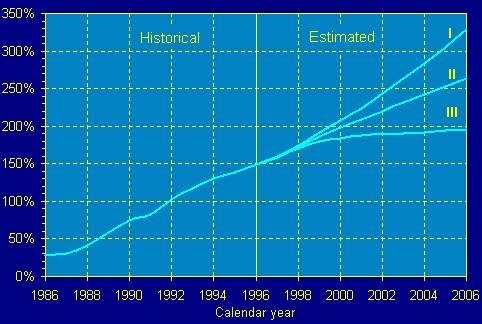
|
However, as also shown in figure I.G2, under the high cost assumptions, not only does DI fail to meet the short-range test of financial adequacy, the DI Trust Fund is projected to be exhausted soon after the end of the short-range projection period. This situation is similar to projections made for the 1996 Annual Report.
Figure I.G2.DI Trust Fund Ratios[Assets as a percentage of annual expenditures] |
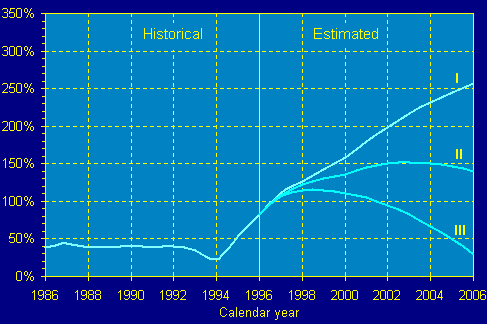
|
Figure I.G3.Trust Fund Ratios for OASI and DI Trust Funds, Combined[Assets as a percentage of annual expenditures] |
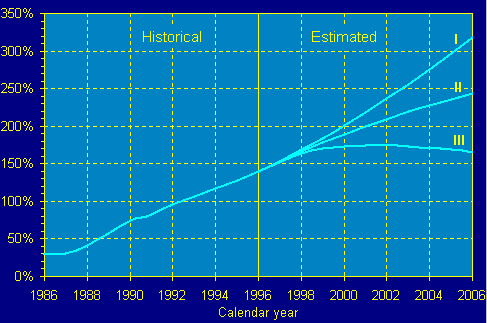
|
As shown, the trust fund ratio for OASI and DI on a combined basis is
estimated to increase from 153 percent at the beginning of 1997 to 244
percent by 2006, based on the intermediate assumptions. Based on
the low cost assumptions, the ratio would also increase throughout
the 10-year period. Under the high cost assumptions, however, the
ratio would be lower at the beginning of 2002, and each year thereafter, than it was at the beginning of the previous year (but would
remain above 100 percent throughout the short-range period).
Because the trust fund ratio for the combined funds is estimated to
remain above 100 percent under the intermediate assumptions, the
combined funds meet the short-range test of financial adequacy.
H. LONG-RANGE ACTUARIAL ESTIMATES
Each year estimates of the financial and actuarial status of the OASDI program are prepared for the next 75 years. Although financial estimates for periods as long as 75 years are inherently uncertain, the results can provide valuable information for use by policymakers. In particular, such estimates can indicate whether the program -- as seen from today's vantage point -- is considered to be in satisfactory financial condition.
As mentioned previously, a number of different measures are useful in evaluating the financial status of the trust funds over the next 75 years. In addition to the actuarial balance and the trust fund ratio, emphasis is placed on the relationship between the levels of future tax income and future expenditures for each year (relative to the amount of earnings subject to the OASDI payroll tax). The year-by-year patterns of this relationship are of particular interest.
In addition to the presentation of long-range estimates, a specific test of the program's long-range financial status is applied. This test is referred to as the test for long-range "close actuarial balance."
Figure I.H1.OASDI Income Rates and Cost Rates[As a percentage of taxable payroll] |
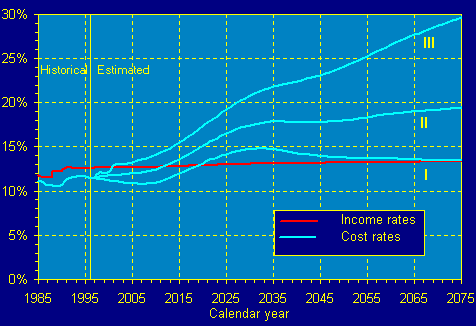
|
For calendar year 1997, the income rate for the OASDI program is
estimated to be about 12.63 percent of taxable payroll. This rate is
made up of the combined tax rate payable by employees and employers,
12.40 percent, plus the revenue from the income taxation of
OASDI benefits, equivalent to 0.23 percent of taxable payroll. Since
OASDI payroll tax rates are not scheduled to change in the future
under present law, payroll tax income as a percentage of taxable payroll
remains constant at about 12.40 percent. Income from the taxation of benefits
will gradually increase, primarily because a greater
proportion of benefits will become subject to taxation. Thus, the
income rate is projected to increase somewhat from its current level,
reaching about 13.33 percent of taxable payroll by the year 2071. The
income rate projection shown in figure I.H1
is based on the intermediate set of assumptions (alternative II) only; the
projections under the
low cost and high cost sets of assumptions (alternatives I and III,
respectively) are very similar.
As figure I.H1 indicates, the pattern followed by the estimated cost rates is much different. Costs as a percentage of taxable payroll are estimated to rise slowly for about 13 years (or to decline slowly, in the case of alternative I) and then to increase rapidly for about the next 20 years. Thereafter, cost rates are estimated to grow less rapidly (or to decline somewhat, in the case of alternative I). By the year 2071 the cost rate is estimated to have reached 13.45 percent, 19.23 percent, and 28.91 percent under alternatives I, II, and III, respectively.
The primary reason that the estimated OASDI cost rate increases rapidly after about 2010 is that the number of beneficiaries is projected to increase more rapidly than the number of covered workers. Because the cost rate expresses expenditures (primarily payments to beneficiaries) as a percentage of taxable payroll (the taxable earnings of covered workers), there is a close relationship between the demographic characteristics of the population and the OASDI cost rate.
Figure I.H2 shows the estimated number of covered workers per
OASDI beneficiary. In 1996, there were about 3.3 workers for every
beneficiary. As indicated, this ratio is expected to decline substantially
in the future under all three sets of assumptions. The most rapid
decline will occur as the relatively large number of persons born during the
"baby boom" (from the end of World War II through the mid-1960s)
reaches retirement age and begins to receive benefits. At the
same time, the relatively small number of persons born during the
subsequent period of low fertility rates will comprise the labor force.
Between 2030 and 2050, the number of workers per beneficiary is relatively
stable as the "baby-boom" generation diminishes in size. After
the year 2050, this ratio will continue to decline at a slower pace for
the intermediate and high cost projections, reflecting the increasing
numbers of beneficiaries due to assumed increases in life expectancy.
Based on the low cost assumptions, a slow increase in this ratio is projected
to occur after 2050. By the end of the 75-year projection period,
the number of workers per beneficiary is projected to decline to 2.4,
1.8, and 1.3 under the low cost (alternative I), intermediate (alternative II),
and high cost (alternative III) assumptions, respectively.
Figure I.H2.Number of Workers Per Beneficiary |
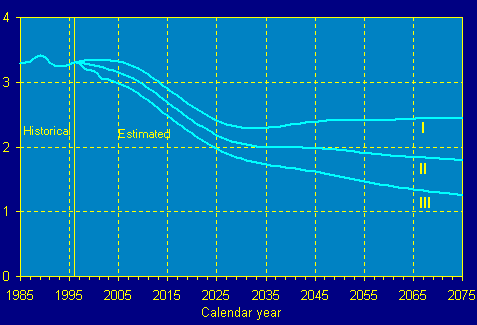
|
The difference between the income rate and the cost rate in a given
year is referred to as the "annual balance" for that year. The estimated
pattern of the OASDI annual balance depends significantly on
the economic and demographic conditions assumed to occur in the
future. Income rates are estimated to exceed cost rates until 2019,
2012, and 2001, under alternatives I, II, and III, respectively, resulting
in positive annual balances. Thereafter, under the intermediate
assumptions, the annual deficit would rise rapidly, reaching 4.38 percent
of taxable payroll by 2030 and 5.90 percent in the year 2071.
Under alternative I, a temporary period of deficits in excess of 1 percent
of taxable payroll (from 2024 through 2043) would be followed by
a return to relatively small deficits lasting throughout the remainder
of the projection period. Under adverse conditions, as assumed in
alternative III, the deficit would grow very rapidly, to over 15 percent
of taxable payroll by the year 2071.
2. Summarized Income Rates, Cost Rates, and Balances
It is useful to consider the income and cost rates on a summarized
basis over the three 25-year subperiods that make up the 75-year projection
period. For this purpose, the annual income rates are summarized by
calculating the present value of future tax income for the
subperiod in question, and expressing it as a percentage of the
present value of future taxable payroll for that subperiod. ("Present
values" are used in financial analysis to calculate the lump-sum
equivalent value, at a particular point in time, of a series of future
amounts or transactions. See the Glossary for additional information.)
Similarly, a summarized cost rate is calculated, based on the present
value of future expenditures as a percentage of the present value of
future taxable payroll. The following table shows these summarized
amounts for the OASDI program for the three 25-year subperiods.
Table I.H1. OASDI Income and Cost Rates for 25-Year Subperiods | |||
| Income rate |
Cost rate |
Balance | |
| Intermediate: | |||
| 1997-2021 | 12.72 | 12.76 | -0.04 |
| 2022-2046 | 13.08 | 17.41 | -4.33 |
| 2047-2071 | 13.24 | 18.62 | -5.38 |
| Low Cost: | |||
| 1997-2021 | 12.68 | 11.55 | 1.13 |
| 2022-2046 | 12.95 | 14.42 | -1.47 |
| 2047-2071 | 13.01 | 13.74 | -.73 |
| High Cost: | |||
| 1997-2021 | 12.77 | 14.17 | -1.41 |
| 2022-2046 | 13.26 | 21.20 | -7.95 |
|
2047-2071 |
13.61 |
26.14 |
-12.52 |
A small deficit is shown under the intermediate alternative II
assumptions for the first subperiod; thereafter, the program is projected
to experience substantial deficits, for the reasons outlined previously. Under
the low cost alternative I assumptions, summarized
tax income would exceed summarized costs for the first 25-year subperiod only,
with deficits diminishing to relatively low levels in the
third subperiod. (The less favorable outlook for the second subperiod
occurs under the low cost assumptions because the "baby-boom" generation is
retired essentially throughout this period, while the
assumed higher ultimate fertility rates have not yet had their full
effect on the estimated numbers of workers.) If the high cost conditions of
alternative III are experienced, substantial deficits would
occur for all three subperiods.
To assess the overall financial balance for the long range, it is customary to
calculate summarized income rates and cost rates for the full
75-year valuation period. For this purpose, summarized income and
cost rates are calculated on a present-value basis, as before. In addition,
the summarized income rate is augmented by the value of trust
fund assets on hand at the beginning of the period. Similarly, the
summarized cost rate is adjusted to include the additional cost of
accumulating trust fund assets at the end of the period equal to 100
percent of the following year's expenditures. The results of this
calculation are shown in the following table.
Table I.H2. OASDI Income and Cost Rates for 75-Year Valuation Period | |||
| Income rate |
Cost rate |
Balance | |
| Intermediate: | |||
| 1997-2071 | 13.37 | 15.60 | -2.23 |
| Low Cost: | |||
| 1997-2071 | 13.25 | 13.03 | .21 |
| High Cost: | |||
|
1997-2071 |
13.53 |
19.07 |
-5.54 |
The difference between the summarized income and cost rates for the
75-year valuation period is called the "actuarial balance" and ranges
from a surplus of 0.21 percent of taxable payroll under the low cost
assumptions to a deficit of 5.54 percent under the high cost assumptions.
Based on the intermediate assumptions, an actuarial deficit of
2.23 percent is projected, representing the difference between the
summarized income rate of 13.37 percent and the corresponding cost
rate of 15.60 percent.
The estimated actuarial deficit is slightly larger than the corresponding deficit of 2.19 percent of payroll in last year's report. If the only change for this year's report were to change the long-range valuation period from 1996-2070 to 1997-2071, the deficit for this year's report would have risen to 2.27 percent of payroll. However, there were a number of other changes that, in net, partially offset the effect of the change in valuation period. See section II.F2g for complete details on the change in actuarial balance from last year's report.
The size of the actuarial balance for any valuation period represents a measure of the program's financial adequacy for that period. The actuarial balance can be interpreted as the amount of change which, if made to the payroll tax rates scheduled under present law for each year in the period, would bring the program into exact actuarial balance. For example, if the 75-year actuarial deficit of 2.23 percent under intermediate assumptions were addressed by raising scheduled tax rates by 1.12 percent for employees and employers, each, and by 2.24 percent for the self-employed, then OASDI assets at the beginning of 1997, together with income from payroll taxes, interest, and other sources, would be just sufficient to meet all expenditures for the period and leave a trust fund level at the end of the period equal to about 100 percent of the following year's expenditures. Of course, there are numerous other changes to tax rates or benefit provisions that could also result in the elimination of the long-range actuarial deficit.
The 75-year actuarial balance is a convenient and widely used measure of the OASDI program's overall financial status. It is important to remember, however, that this summary measure reflects the combined effects of several very different periods, as previously described. Thus, while the use of summary measures such as the actuarial balance is often convenient, such measures should not be used as a substitute for a more complete understanding of the underlying year-by-year outlook.
3. Trust Fund Ratios
As noted previously, the total income of the OASDI program currently
exceeds total expenditures by a substantial margin. As a result, the
assets of the combined trust funds are increasing rapidly. Under the
intermediate alternative II assumptions, tax income is expected to
exceed expenditures until 2012, when the cost of the program will
have started to increase with the retirement of the "baby-boom" generation.
From that point on the tax rates scheduled in present law are
expected to be insufficient to cover program expenditures and it will
be necessary to use interest earned by the combined OASI and DI
Trust Funds to make up the shortfall. Total income, including interest
earnings, is expected to exceed expenditures through about 2018.
Thereafter, it will be necessary to redeem assets to make up the shortfall.
If no corrective action were taken, trust fund assets would be
exhausted by the end of 2029, after which full benefits would not be
payable on a timely basis. The resulting pattern of combined OASI
and DI assets, expressed as a percentage of annual expenditures, is
illustrated in figure I.H3 under each of the three alternative sets of
assumptions.
At the beginning of 1997, the combined assets of the OASI and DI
Trust Funds represented about 153 percent of combined annual
expenditures estimated for the year. Based on the intermediate
assumptions, assets would accumulate to a peak of 265 percent of
expenditures in 2011, and would then decline steadily until exhaustion
in the year 2029. Based on the intermediate estimates in last
year's report, the peak fund ratio for the combined funds was estimated
to be 245 percent in 2011 and the year of exhaustion was also
estimated to be 2029.
Figure I.H3.Trust Fund Ratios for OASI and DI Trust Funds, Combined[Assets as a percentage of annual expenditures] |
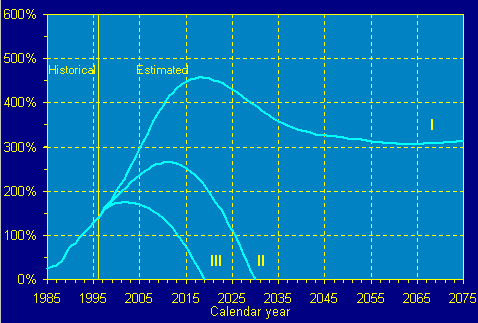
|
For OASI and DI, separately, the peak fund ratios based on the intermediate
assumptions are 306 and 152 percent, respectively, in this
year's report and 284 percent and 136 percent, respectively, in last
year's report. The following table summarizes the projections in this
year's report for OASI, DI, and the combined trust funds under the
three sets of assumptions for the period 1997 through 2071.
Table I.H3. OASDI Trust Fund Ratios | ||||
| OASI |
DI |
Combined | ||
| Intermediate: | ||||
| Maximum trust fund ratio (percent) | 306 | 152 | 265 | |
| Year attained | 2013 | 2003 | 2011 | |
| Year of exhaustion | 2031 | 2015 | 2029 | |
| Low Cost: | ||||
| Maximum trust fund ratio (percent) | 469 | 1,276 | 457 | |
| Year attained | 2017 | 2071 | 2018 | |
| Year of exhaustion | - | - | - | |
| High Cost: | ||||
| Maximum trust fund ratio (percent) | 195 | 115 | 175 | |
| Year attained | 2007 | 1998 | 2001 | |
|
Year of exhaustion |
2022 |
2007 |
2018 | |
Under the low cost alternative I assumptions, the combined trust
fund ratio rises rapidly until the retirement of the "baby-boom"
generation, declines during the retirement years of the "baby-boom"
generation, but levels off and then resumes increasing after 2060, even
though annual balances are negative. This occurs because the
assumed trust fund interest rates are high enough to offset the small
annual deficits and still keep the trust funds growing faster than
annual outgo. For the high cost alternative III, the combined trust
fund is permanently exhausted in 2018.
Trust fund assets are generally invested in special Treasury securities so that the excess of cash receipts over expenditures are borrowed from the trust funds by the general fund of the Treasury and used to help meet various Federal outlays. These securities are backed by the full faith and credit of the U.S. Government, the same as other public-debt obligations of the U.S. Government. The assets of the trust funds can be redeemed for cash at any time if required to meet program expenditures. The redemption of a Treasury security held by a trust fund requires that the Treasury transfer cash -- obtained from another revenue source, such as income taxes or borrowing from the public -- to the trust fund. Thus, the investment operations of the trust funds result in various cash flows between the trust funds and the general fund of the Treasury.
Under the intermediate assumptions, the excess of OASDI income over outgo during the next 15 years will result in a substantial net cash flow from the trust funds of amounts borrowed by the general fund. Thereafter, this cash flow is expected to reverse; as trust fund securities are redeemed to meet benefit payments and other expenditures, revenue from the general fund of the Treasury will be drawn upon to provide the necessary cash. The accumulation and subsequent redemption of substantial trust fund assets has important economic and public policy implications that go well beyond the operation of the OASDI program itself. Discussion of these broader issues is not within the scope of this report.
4. Test of Long-Range Close Actuarial Balance
Because the OASI and DI programs, both separately and combined,
have actuarial deficits that are more than 5 percent of the corresponding
summarized cost rates over the next 75 years under the Trustees'
intermediate (alternative II) assumptions, they do not meet the
requirements of the Trustees' formal test for long-range close actuarial
balance. (This test is described in detail in section
II.F entitled "Actuarial Estimates" later in this report.)
The intermediate estimates indicate that the combined trust funds
would be sufficient to enable the timely payment of benefits for the
next 32 years. Relative to annual expenditures, the combined trust
funds would continue to grow during the next 14 years, reaching a
peak of about 2.6 times annual expenditures. Considering each fund
separately, the OASI Trust Fund would have sufficient funds for the
next 34 years, and the DI Trust Fund for the next 18 years, to enable
timely payment of benefits. Based on the high cost assumptions, the
combined funds would be sufficient to enable the timely payment of
benefits only for the next 21 years.
3. Recommendations
In view of the lack of close actuarial balance in the OASDI program
over the next 75 years, we again urge that the long-range deficits of
both the OASI and DI Trust Funds be addressed in a timely way.
Because the DI Trust Fund is expected to be depleted several years
earlier than the OASI Trust Fund, and because DI program growth
has fluctuated widely in the past, it is essential that the DI program's
future experience be monitored closely.
It is important to address both the OASI and DI problems soon to
allow time for phasing in any necessary changes and for workers to
adjust their retirement plans to take account of those changes. The
proposals in the recent Advisory Council Report and others being
advanced by public officials and private organizations should be carefully evaluated by the government and the public. It is essential that
the financial status of the Social Security program be strengthened
and maintained.
| |
Privacy Policy | Website Policies & Other Important Information | Site Map | |